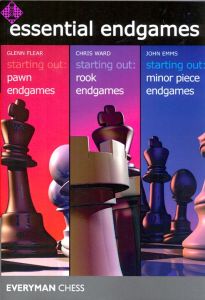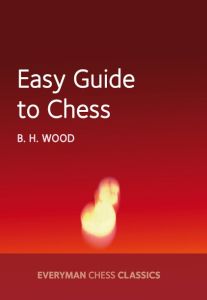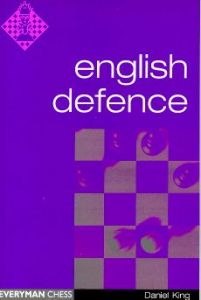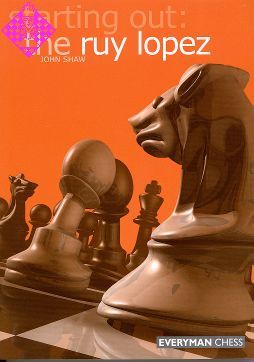The Ruy Lopez
144 Seiten, kartoniert, Everyman, 1. Auflage 2003
Aus der Reihe »Starting Out«
These books are perfect for enthusiastic chess players who are starting out in the game, and who are seeking to understand the basic principles behind these important openings. These books are written in a user-friendly style with an abundance of notes, tips and warnings scattered throughout while key strategies, ideas and tactics for both sides are clearly illustrated. The authors of these books are very skilled and experienced chess writers, who are used to writing for players of all levels and are renowned for their ability to explain ideas in a lucid and straightforward manner.
International Master John Shaw is a three-time Scottish champion
Ideal for those wanting to understand the basics of the Ruy Lopez.
The Ruy Lopez is one of the most famous of all chess openings. It has a long and distinguished history and has been played by virtually all of the strongest Grandmasters: Fischer, Karpov, Kasparov, Kramnik, Anand - the list goes on! From very early on White activates his pieces, takes the initiative and sets about building a dominant centre. In this user-friendly book, John Shaw goes back to basics, studying the fundamental principles of the Ruy Lopez and its many variations.
Throughout the book there are an abundance of notes, tips, warnings and exercises to help the improving player, while key strategies, ideas and tactics for both sides are clearly illustrated.
- User-friendly design to help readers absorb ideas
- Concentrates on the key principles of the Ruy Lopez
- Ideal for the improving player
The Ruy Lopez refers to the position after 1 e4 e5 2 Nf3 Nc6 3 Bb5 and is one of the oldest and most respected chess openings. The name refers to a Spanish priest thus explaining the alternative name for the Lopez which I use interchangeably throughout the book. Although there are many very different variations within the Lopez they often have a common theme - White wishes to dominate the centre. The move 3 Bb5 begins a plan to build pressure against Black's e5 pawn and its supporters. White even has a standard piece development, a Spanish autopilot, which is as follows: 0-0, Re1, c2-c3, d2-d4 and Nb1-d2-f1-g3. Of course, some of Black's sharper defences may prevent this but it is possible in many games.
It should not be difficult to convince doubters that the Lopez is an opening well worth learning. Many of the world's top players rely on the Lopez as the backbone of their repertoire, with Garry Kasparov being the latest in a long and celebrated line including Bobby Fischer and Anatoly Karpov. But the Lopez is not just a strong opening, it leads to positions which are generally highly instructive about chess. Indeed, many distinguished players have made the suggestion that if a player wishes to understand chess he should try to understand the Ruy Lopez.
A few important points should be made about the structure and objective of this book. It is divided into chapters and sections covering all the most important Lopez variations. Each section starts with a brief description of the variation under consideration before using illustrative games to provide more detail. The book is intended as an introduction to the plans and ideas of the Ruy Lopez rather than a high level theoretical manual. I would also hope, however, that the book contains enough original analysis to be of interest to players already familiar with the basic ideas in the Lopez.
John Shaw, Scotland, May 2003, Introduction
These books are perfect for enthusiastic chess players who are starting out in the game, and who are seeking to understand the basic principles behind these important openings. These books are written in a user-friendly style with an abundance of notes, tips and warnings scattered throughout while key strategies, ideas and tactics for both sides are clearly illustrated. The authors of these books are very skilled and experienced chess writers, who are used to writing for players of all levels and are renowned for their ability to explain ideas in a lucid and straightforward manner.
International Master John Shaw is a three-time Scottish champion
Ideal for those wanting to understand the basics of the Ruy Lopez.
The Ruy Lopez is one of the most famous of all chess openings. It has a long and distinguished history and has been played by virtually all of the strongest Grandmasters: Fischer, Karpov, Kasparov, Kramnik, Anand - the list goes on! From very early on White activates his pieces, takes the initiative and sets about building a dominant centre. In this user-friendly book, John Shaw goes back to basics, studying the fundamental principles of the Ruy Lopez and its many variations.
Throughout the book there are an abundance of notes, tips, warnings and exercises to help the improving player, while key strategies, ideas and tactics for both sides are clearly illustrated.
- User-friendly design to help readers absorb ideas
- Concentrates on the key principles of the Ruy Lopez
- Ideal for the improving player
The Ruy Lopez refers to the position after 1 e4 e5 2 Nf3 Nc6 3 Bb5 and is one of the oldest and most respected chess openings. The name refers to a Spanish priest thus explaining the alternative name for the Lopez which I use interchangeably throughout the book. Although there are many very different variations within the Lopez they often have a common theme - White wishes to dominate the centre. The move 3 Bb5 begins a plan to build pressure against Black's e5 pawn and its supporters. White even has a standard piece development, a Spanish autopilot, which is as follows: 0-0, Re1, c2-c3, d2-d4 and Nb1-d2-f1-g3. Of course, some of Black's sharper defences may prevent this but it is possible in many games.
It should not be difficult to convince doubters that the Lopez is an opening well worth learning. Many of the world's top players rely on the Lopez as the backbone of their repertoire, with Garry Kasparov being the latest in a long and celebrated line including Bobby Fischer and Anatoly Karpov. But the Lopez is not just a strong opening, it leads to positions which are generally highly instructive about chess. Indeed, many distinguished players have made the suggestion that if a player wishes to understand chess he should try to understand the Ruy Lopez.
A few important points should be made about the structure and objective of this book. It is divided into chapters and sections covering all the most important Lopez variations. Each section starts with a brief description of the variation under consideration before using illustrative games to provide more detail. The book is intended as an introduction to the plans and ideas of the Ruy Lopez rather than a high level theoretical manual. I would also hope, however, that the book contains enough original analysis to be of interest to players already familiar with the basic ideas in the Lopez.
John Shaw, Scotland, May 2003, Introduction
| Gewicht | 275 g |
|---|---|
| Hersteller | Everyman |
| Breite | 17,3 cm |
| Höhe | 24,3 cm |
| Medium | Buch |
| Erscheinungsjahr | 2003 |
| Autor | John Shaw |
| Reihe | Starting Out |
| Sprache | Englisch |
| Auflage | 1 |
| ISBN-10 | 1857443217 |
| ISBN-13 | 9781857443219 |
| Seiten | 144 |
| Einband | kartoniert |
005 Introduction
006 1 Third Move Options for Black
040 2 Fourth Move Options
062 3 Fifth and Sixth Move Options
089 4 The Marshall Attack and Rare Closed Lines
110 5 Main Line Closed Ruy Lopez
141 Index of Complete Games
143 Index of Variations
The Ruy Lopez refers to the position after 1 e4 e5 2 Nf3 Nc6 3 Bb5 and is one of the oldest and most respected chess openings. The name refers to a Spanish priest thus explaining the alternative name for the Lopez which I use interchangeably throughout the book. Although there are many very different variations within the Lopez they often have a common theme - White wishes to dominate the centre. The move 3 Bb5 begins a plan to build pressure against Black's e5 pawn and its supporters. White even has a standard piece development, a Spanish autopilot, which is as follows: 0-0, Re1, c2-c3, d2-d4 and Nb1-d2-f1-g3. Of course, some of Black's sharper defences may prevent this but it is possible in many games.
It should not be difficult to convince doubters that the Lopez is an opening well worth learning. Many of the world's top players rely on the Lopez as the backbone of their repertoire, with Garry Kasparov being the latest in a long and celebrated line including Bobby Fischer and Anatoly Karpov. But the Lopez is not just a strong opening, it leads to positions which are generally highly instructive about chess. Indeed, many distinguished players have made the suggestion that if a player wishes to understand chess he should try to understand the Ruy Lopez.
A few important points should be made about the structure and objective of this book. It is divided into chapters and sections covering all the most important Lopez variations. Each section starts with a brief description of the variation under consideration before using illustrative games to provide more detail. The book is intended as an introduction to the plans and ideas of the Ruy Lopez rather than a high level theoretical manual. I would also hope, however, that the book contains enough original analysis to be of interest to players already familiar with the basic ideas in the Lopez.
John Shaw, Scotland, May 2003, Introduction
John Shaw, dreifacher schottischer Meister und Autor mit einschlägigen Erfahrungen in Sachen Eröffnungsliteratur, erkennbar an seiner unlängst erschienenen Monografie "The Queen's Gambit" im gleichen Verlag, lässt sich vorliegend über die altehrwürdige Spanische Partie aus. Am Beispiel von nicht weniger als 80 Partien beleuchte der Autor die zurzeit gängigsten Abspiele in der Meisterpraxis nach den Zügen 1. e4 e5 2. Sf3 Sc6 3. Lb5. Wir haben es zu tun mit einer topaktuellen Sammlung an Partienmaterial, welches innerhalb des Zeitraums 1996-2003(!) entstanden ist und nun mit ausführlichen Anmerkungen versehen der Öffentlichkeit vorgestellt wird. Der Autor hat sein Werk in fünf Großkapitel eingeteilt, wobei jedes wiederum in verschiedene Unterkapitel gegliedert ist. Frei übersetzt und interpretiert sieht die Komposition des Buches wie folgt aus:
Kapitel 1 (Optionen für Schwarz im 3. Zug): Berliner Verteidigung, Jänisch-Gambit, Seltene Verteidigungen
Kapitel 2 (Beidseitige Optionen im 4. Zug): Abtausch-Variante, Nebenvarianten nach 4. La4
Kapitel 3 (Optionen im 5. und 6. Zug): Offener Spanier, Archangelsk-Variante, Möller-Variante, Nebenvarianten nach 4. La4 Sf6
Kapitel 4 (Marshall-Angriff und seltene geschlossene Abspiele): Marshall-Angriff, Anti-Marshall, Seltene geschlossene Abspiele
Kapitel 5 (Geschlossene Hauptvariante): Saizew-Variante, Smyslow-Variante, Breyer-Variante, Tschigorin-Variante
Eine noch detailliertere Differenzierung erfährt unser Buch durch einen Variantenindex am Schluss, wo sich der Leser ein genaues Bild über Haupt-, Neben-, Unter- und Subvarianten verschaffen kann.
Wer aber ist dieser potenzielle Leser? Sicherlich nicht derjenige, der sich mit dem Gedanken eines Repertoire Wechsels etwa von 1.d4 nach 1.e4 trägt. Umsteiger sollten sich zunächst zumindest ansatzweise mit der Geschichte dieser Eröffnung beschäftigt haben, die in unserem Buch natürlich nicht zu finden ist. Viel eher eignet es sich für denjenigen, der in Sachen Spanische Partie einschlägige praktische Erfahrungen mitbringt und sich schon lange mit der Absicht trägt, sein angestaubtes Eröffnungswissen endlich einmal zu aktualisieren. Der Autor John Shaw gehört übrigens höchstpersönlich zum Anwenderkreis des Spaniers, was der Qualität seiner Anmerkungen sicherlich keinen Abbruch tut.
Nicht unerwähnt bleiben sollte, dass "The Ruy Lopez" einen sehr leserfreundlichen Eindruck hinterlässt, wie sich an den zahlreichen Diagrammen (bis zu 2 pro Seite), dem variablen Layout und nicht zuletzt den "unterwegs" immer wieder anzutreffenden Warnungs- und Hinweistafeln zeigt. Einziger Wermutstropfen ist für uns Kontinentaleuropäer die englische Sprache, die aber dank unser aller Schulkarriere kein unüberwindbares Hindernis darstellen sollte.
E. Carl, Rochade Europa 09/2003 Der englische Verlag Everyman Chess hat seine vor allem für weniger erfahrene Spieler bestens geeignete Reihe von "starting out"-Büchern erneut erweitert.
Wie gewohnt konzentrieren sich die Autoren in den "starting out"-Büchern darauf, den Leser mit den wichtigsten Motiven und Strategien der üblichen Hauptvarianten vertraut zu machen und so ein gutes Grundverständnis für die Eröffnung zu schaffen, anstatt den, Leser mit unzähligen Varianten zuzuschütten. Zu jedem wichtigen Abspiel zeigt eine einführende Übersicht zunächst, in welchen Bahnen das Spiel verläuft und worauf es zu achten gilt. Danach zeigen gut kommentierte Musterpartien, wie sich das Spiel typischerweise entwickeln kann.
"The ruy Lopez" arbeitet sich in fünf Kapiteln von weniger gebräuchlichen Varianten im dritten Zug bis hin zu den Hauptvarianten im geschlossenen Spanier durch. Insgesamt werden darin 15 Hauptabspiele besprochen, in den insgesamt 80 Musterpartien finden sich aber natürlich auch zahlreiche Ergänzungen zu weniger bedeutenden Varianten.
Schachmarkt 4/2003
-
 Fighting Chess with Black24,95 €
Fighting Chess with Black24,95 € -
 Essential Endgames24,95 €
Essential Endgames24,95 € -
 Easy guide to chess17,95 €
Easy guide to chess17,95 € -
 English defence17,95 €
English defence17,95 € -
 Fighting the Anti-King's Indian19,95 €
Fighting the Anti-King's Indian19,95 € -
 Fighting Chess: Move by Move22,95 €
Fighting Chess: Move by Move22,95 € - Mehr von Everyman


